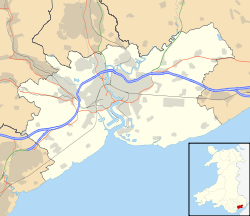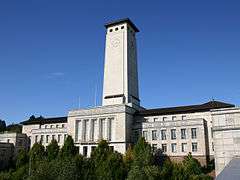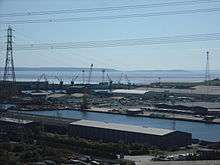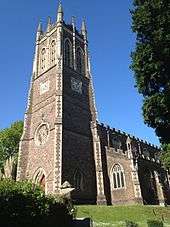Newport, Wales
Newport (/ˈnjuːpɔːrt/; Welsh: Casnewydd) is a cathedral and university city and unitary authority area in south east Wales. It is located on the River Usk close to its confluence with the Severn estuary, approximately 12 miles (19 km) northeast of Cardiff. At the 2011 census it is the third largest city in Wales, with a city population of 145,700[1] and an urban population of 306,844. The city forms part of the Cardiff-Newport metropolitan area with a population of 1,097,000.
Newport has been a port since medieval times, when Newport Castle was built by the Normans. The town outgrew the earlier Roman town of Caerleon, immediately upstream, and gained its first charter in 1314. It grew significantly in the 19th century, when its port became the focus of coal exports from the eastern valleys of South Wales. Until the rise of Cardiff from the 1850s, Newport was Wales' largest coal-exporting port. It was the site of the last large-scale armed insurrection in Britain, the Newport Rising of 1839 led by the Chartists.
During the 20th century, when the docks declined in importance, Newport remained an important manufacturing and engineering centre. It was granted city status in 2002. Newport hosted the Ryder Cup in 2010. The city was the venue of the 2014 NATO summit.[2]
It is the largest urban area within the historic county boundaries of Monmouthshire and the preserved county of Gwent. The City of Newport, which includes some surrounding rural areas as well as the built up area, is governed by Newport City Council.
History
Origins


Bronze Age fishermen settled around the fertile estuary of the River Usk and later the Celtic Silures built hillforts overlooking it. In AD 75, on the very edge of their empire, the Roman legions built a Roman fort at Caerleon to defend the river crossing. According to legend, in the late 5th century Saint Woolos church was founded by Saint Gwynllyw, the patron saint of Newport and King of Gwynllwg. The church was certainly in existence by the 9th century and today has become Newport Cathedral, the seat of the Bishop of Monmouth. The Normans arrived from around 1088–1093 to build Newport Castle and river crossing downstream and the first Norman Lord of Newport was Robert Fitzhamon.
The settlement of 'Newport' is first mentioned as novo burgus established by Robert, Earl of Gloucester in 1126.[3] The name was derived from the original Latin name Novus Burgus, meaning new borough or new town. The city can sometimes be found labelled as Newport-on-Usk on old maps.[4] The original Welsh language name for the city, Casnewydd-ar-Wysg (pronounced [kasˈnɛwɪð ar ˈwɪsk]) means 'New castle-on-Usk' (this is a shortened version of Castell Newydd ar Wysg) and this refers to the twelfth-century castle ruins near Newport city centre. The original Newport Castle was a small motte-and-bailey castle in the park opposite Newport Cathedral. It was buried in rubble excavated from the Hillfield railway tunnels that were dug under Stow Hill in the 1840s and no part of it is currently visible.[5]
Around the settlement, the new town grew to become Newport, obtaining its first charter in 1314[6] and was granted a second one, by Hugh Stafford, 2nd Earl of Stafford in 1385. In the 14th century friars came to Newport where they built an isolation hospital for infectious diseases. After its closure the hospital lived on in the place name "Spitty Fields" (a corruption of ysbyty, the Welsh for hospital).[7] "Austin Friars" also remains a street name in the city.
During the Welsh Revolt in 1402 Rhys Gethin, General for Owain Glyndŵr, forcibly took Newport Castle together with those at Cardiff, Llandaff, Abergavenny, Caerphilly, Caerleon and Usk.[8] During the raid the town of Newport was badly burned and Saint Woolos church destroyed.
A third charter, establishing the right of the town to run its own market and commerce came from Humphrey Stafford, 1st Duke of Buckingham in 1426. By 1521, Newport was described as having "....a good haven coming into it, well occupied with small crays [merchant ships] where a very great ship may resort and have good harbour." Trade was thriving with the nearby ports of Bristol and Bridgwater and industries included leather tanning, soap making and starch making.[7] The town's craftsmen included bakers, butchers, brewers, carpenters and blacksmiths. A further charter was granted by James I in 1623.
During the English Civil War in 1648 Oliver Cromwell's troops camped overnight on Christchurch Hill overlooking the town before their attack on the castle the next day. A cannonball dug up from a garden in nearby Summerhill Avenue, dating from this time, now rests in Newport Museum.[9]
Industrial Revolution
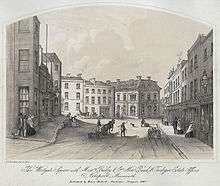

As the Industrial Revolution took off in Britain in the 19th century, the South Wales Valleys became key suppliers of coal from the South Wales Coalfield, and iron. These were transported down local rivers and the new canals to ports such as Newport, and Newport Docks grew rapidly as a result. Newport became one of the largest towns in Wales and the focus for the new industrial eastern valleys of South Wales. By 1830 Newport was Wales' leading coal port, and until the 1850s it was larger than Cardiff.[3]
The Newport Rising in 1839 was the last large-scale armed rebellion against authority in mainland Britain. John Frost and 3,000 other Chartists marched on the Westgate Hotel at the centre of the town. The march was met with an attack by militia, called to the town by the Mayor, Thomas Phillips: at least 20 marchers were killed and were later buried in Saint Woolos churchyard. John Frost was sentenced to death for treason, but this was later commuted to transportation to Australia. He returned to Britain (but not to Newport) later in his life. John Frost Square (1977), in the centre of the city, is named in his honour.
Newport probably had a Welsh-speaking majority until the 1830s, but with a large influx of migrants from England and Ireland over the following decades, the town and the rest of Monmouthshire came to be seen as "un-Welsh", a view compounded by ambiguity about the status of Monmouthshire.[3] In the 19th century, the St George Society of Newport (a group largely consisting of English settlers and businessmen) asserted that the town was part of England. It was at a meeting in Newport, attended by future Prime Minister David Lloyd George, that the Cymru Fydd movement received its death blow in 1896 when politician Robert Bird stated “You will find, from Swansea to Newport, a cosmopolitan population who will not submit to the domination of Welsh ideas!”.[3] In 1922 Lloyd George was to suffer a further blow in Newport, when the South Wales Liberal Federation, led by David Alfred Thomas, an industrialist and Liberal politician, and Robert Bird moved that Lloyd George "be not heard" in the 1895 General Election. The Conservative capture of the recently created Newport constituency in a by-election in 1922 was one of the causes of the fall of his coalition government.[3]
The late 19th and early 20th century period was a boom time for Newport. The Alexandra Docks opened in 1875. The population was expanding rapidly and the town became a county borough in 1891.[3] In 1892 the Alexandra South Dock was opened and was the largest masonry dock in the world.[3] Although coal exports from Newport were by now modest compared to the Port of Cardiff (which included Cardiff, Penarth and Barry), Newport was the place where the Miners' Federation of Great Britain was founded in 1889, and international trade was sufficiently large for 8 consuls and 14 vice-consuls to be based in the town.[3] In 1898 Lysaght's Orb Works opened and by 1901 employed 3,000 staff. Urban expansion took in Pillgwenlly and Lliswerry to the south; this eventually necessitated a new crossing of the River Usk, which was provided by the Newport Transporter Bridge completed in 1906, described as "Newport's greatest treasure".[3]
Further extensions to the South Dock were opened in 1907 and 1914. The Newport Docks Disaster occurred on 2 July 1909 when, during construction of the new south lock connecting the South Dock to the Severn Estuary, supporting timbers in an excavation trench collapsed and buried 46 workers. The rescuers included 12-year-old paper boy Thomas ‘Toya’ Lewis who was small enough to crawl into the collapsed trench. Lewis worked for two hours with hammer and chisel in an attempt to free one of those trapped who was released the next day. Several hundred pounds was later raised through public subscription in gratitude for the boy's efforts, and he was sent on an engineering scholarship to Scotland. Lewis was awarded the Albert Medal for Lifesaving by King Edward VII in December 1909. A Wetherspoons pub in the city centre is named "The Tom Toya Lewis" after the young hero.[10] The building in which the pub is housed was formerly the Newport YMCA, the Foundation Stone for which was laid by Viscount Tredegar, also in 1909.[11]
From 1893 the town was served by the paddle steamers of P & A Campbell Ltd. (the "White Funnel Line"), which was based in Bristol. The company had been originally set up, by the Scottish brothers Alex and Peter Campbell, on the River Clyde, but was re-located to the Severn Estuary. Departing steamers would face south on Davis Wharf, with the Art College to its left and the town bridge behind. The boats gave rise to the name of the short street which led to the quayside - Screwpacket Road. By 1955 steamers had stopped calling at Newport and P&A Campbell went in to receivership in 1959. It was taken over by the firm which would become the Townsend Ferry group.[12]
The modern era

Compared to many Welsh towns, Newport's economy had a broad base, with foundries, engineering works, a cattle market and shops that served much of Monmouthshire.[3] However, the docks were in decline even before the Great Depression, and local unemployment peaked at 34.7% in 1930: high, but not as bad as the levels seen in the mining towns of the South Wales Valleys. Despite the economic conditions, the council re-housed over half the population in the 1920s and 30s.[3] In 1930 the Town Dock was filled in.
The post-war years saw renewed prosperity, with Saint Woolos Cathedral (now Newport Cathedral) attaining full cathedral status in 1949, the opening of the modern integrated Llanwern steelworks in 1962, and the construction of the Severn Bridge and local sections of the M4 motorway in the late 1960s, making Newport the best-connected place in Wales.[3][13] Although employment at Llanwern steelworks declined in the 1980s, the town acquired a range of new public sector employers, and a Richard Rogers-designed Inmos microprocessor factory helped to establish Newport as being extant for technology companies.[14] A flourishing local music scene in the early 1990s led to claims that the town was "a new Seattle".[3][15]
The county borough of Newport was granted city status in 2002 to mark Queen Elizabeth II's Golden Jubilee.[16] In the same year, an unusually large merchant ship, referred to locally as the Newport Ship, was uncovered and rescued from the west bank of the River Usk during the construction of the Riverfront Arts Centre. The ship has been dated to some time between 1445 and 1469 and it remains the only vessel of its type from this period yet discovered anywhere in the world.
Key dates in Newport's history
- 1140: The first early Norman wood motte and bailey castle is built on Stow Hill.
- 1314: First Town Charter
- 1327–1386: Newport Castle built
- 1385: Second Town Charter granted by Hugh Stafford, 2nd Earl of Stafford
- 1402: Town taken by the forces of Owain Glyndŵr, rebel Prince of Wales during the Welsh Revolt: Saint Woolos Cathedral destroyed.
- 1426: Third Town Charter granted by Humphrey Stafford, 1st Duke of Buckingham
- 1648: Town taken by the forces of Oliver Cromwell during the English Civil War.
- 1672: Tredegar House completed.
- 1796: Opening of the Monmouthshire canal.
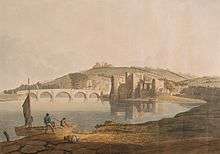
- 1839: Chartist Newport Rising, Westgate Hotel, Newport led by radical former mayor John Frost
- 1842: Newport Town Dock opens – floating dock able to accommodate the largest ships in the world.
- 1858: Town Dock extended to the north
- 1871: W. H. Davies, renowned poet born at Portland Street, Pillgwenlly.
- 1875: Alexandra Dock opens.
- 1877: Athletic grounds at Rodney Parade opens.
- 1887: The Boys Brigade movement in Wales founded by George Philip Reynolds at Havelock Street Presbyterian Church.
- 1892: Alexandra South Dock opens, extended 1907 (phase2) and 1914 (phase3)
- 1880–1900: Godfrey Morgan, 1st Viscount Tredegar donates land for the benefit of the public, including Belle Vue Park, the Royal Gwent Hospital and Newport Athletics Grounds.
- 1894: Belle Vue Park opens.
- 1898: Lysaght's Orb Works steelworks opens.
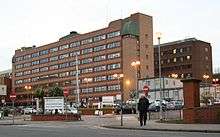
- 1901: Royal Gwent Hospital moves to its current site
- 1906: Newport Transporter Bridge[17] opens on 12 September.
- 1909: Newport Docks Disaster.
- 1930: Town Dock closed and filled in.
- 1937: King George VI visits Newport and cuts first sod of new Civic Centre building.
- 1949: Saint Woolos pro-Cathedral attains full cathedral status, (now Newport Cathedral).
- 1962: Llanwern steelworks opens.
- 1963: Newport rugby club beat the touring New Zealand All Blacks.
- 2002: Newport granted city status; discovery of the Newport Ship.
- 2003: Newport Unlimited regeneration company set up.
- 2010: The Ryder Cup golf competition was hosted at the Celtic Manor Resort.
- 2014: The 2014 NATO summit took place at the Celtic Manor Resort.
- 2015: Friars Walk shopping centre opens.
Governance
Newport has long been the largest town in the historic county of Monmouthshire and became a unitary authority in 1996, although it was also a county borough between 1891 and 1974. The Local Government Act 1972 removed ambiguity about the legal status of the area by including the administrative county of Monmouthshire and the county borough of Newport into all acts pertaining to Wales, and in 1974 the borough was incorporated into the new local government county of Gwent. Gwent itself was abolished in 1996 but remains in use for ceremonial functions as a preserved county.
Politics
- See also Category:Politics of Newport, Wales
The city is historically industrialised with a large working-class population[3] and a strong support for the Labour Party.
Labour lost control of Newport City council in the 2008 local elections to a Conservative/Liberal Democrat coalition but the Labour Party regained an overall majority of councillors in the 2012 election.
The City of Newport is divided between the UK Parliamentary constituencies of Newport West and Newport East and elects one Member of Parliament (MP) in each constituency. The two constituencies cover a similar area to that of the city area controlled by Newport City Council. The city formerly had only one constituency until 1983 when the city was split into Newport West and Newport East due to population growth. In the United Kingdom general election, 2015, Labour held Newport West with a reduced majority of 3,510 votes over the Conservative Party. The Labour Party also held Newport East with an increased majority of 4,705 votes over the Conservative Party.
In the National Assembly of Wales Newport is divided into Newport West and Newport East constituencies and elects one Assembly Minister (AM) in each constituency. In the National Assembly for Wales election, 2016, Labour held Newport West with a reduced majority of 4,115 votes over the Conservative Party. The Labour Party also held Newport East with a reduced majority of 4,896 votes over UKIP.
Newport is part of the Wales European Parliament Constituency. The Wales constituency elects four Members of the European Parliament (MEP). In the 2014 European Parliament election the Wales constituency elected one MEP from each of the Labour, UKIP, Conservative, and Plaid Cymru parties.
| Position | Current Representatives |
|---|---|
| Members of Parliament | |
| Members of the National Assembly for Wales | |
| Members of the European Parliament | Derek Vaughan, Labour, first elected 2009 · Nathan Gill, UKIP, first elected 2014 · Kay Swinburne, Conservative, first elected 2009 · Jill Evans, Plaid Cymru, first elected 1999 |
| Newport City Council Members | See Newport City Council main article |
| Police and Crime Commissioner |
Coat of arms
The official blazon of the armorial bearings is: "(arms) Or, a chevron reversed gules, the shield ensigned by a cherub proper. Supporters: on the dexter side a winged sea lion Or, and on the sinister side a sea dragon gules, the nether parts of both proper, finned gold."
Freedom of the City
The title of Freedom of Newport is a ceremonial honour, given by the Newport council to those who have served in some exceptional capacity, or upon any whom Newport wishes to bestow an honour. There have been 17 individuals or organisations that have received the honour since 1909,[18] including:
- Rt. Hon. Godfrey Charles Morgan, 1st Viscount Tredegar, Lord Lieutenant of Monmouthshire
- Bernard Montgomery, 1st Viscount Montgomery of Alamein (1945) [19]
- Corps of the South Wales Borderers (24th Foot)
- Royal Regiment of Wales (24th/41st Foot)
- 104th Regiment Royal Artillery (Volunteers)
- Royal Welch Fusiliers (2001) [20]
- British Merchant Navy Association
- HMS Severn (2006) [21]
- Newport County A.F.C. (2013) [18]
- Newport R.F.C. (2013)[22]
Geography
Newport is located 138 miles (222 km) west of London and 12 miles (19 km) east of Cardiff. It is the largest urban area within the historic county boundaries of Monmouthshire and the preserved county of Gwent. The City of Newport, which includes rural areas as well as the built up area, is the seventh most populous unitary authority in Wales.
The city is largely low-lying, but with a few hilly areas. (Wentwood reaches 310 metres above sea level). Areas in the south and east of the city tend to be flat and fertile with some housing estates and industrial areas reclaimed from marshland. Areas near the banks of the River Usk, such as Caerleon, are also low-lying. The eastern outskirts of the city are characterised by the gently rolling hills of the Vale of Usk and Christchurch has panoramic views of the Vale of Usk and the Bristol Channel. Ridgeway at Allt-yr-yn also has good views of the surrounding areas and Bristol Channel. Brynglas has views over the city centre and Twmbarlwm to the west. The suburbs of the city have grown outwards from the inner-city, mostly near the main roads, giving the suburban sprawl of the city an irregular shape. The urban area is continuing to expand rapidly with new housing estates continuing to be built.
The city boundaries include a number of villages in the Newport Built-up area.
Wards and districts
- See also Category:Districts of Newport, Wales
The city is divided into 20 wards. Most of these wards are coterminous with communities (parishes) of the same name. Each community can have an elected council. The following table lists city council wards, communities and associated geographical areas. Communities with a community council are indicated with a '*':
| Ward | Communities (Parishes) | Communities |
| Allt-yr-yn | Allt-yr-yn | Ridgeway, Barrack Hill, Glasllwch, Gold Tops |
| Alway | Alway | Somerton, Lawrence Hill |
| Beechwood | Beechwood | Eveswell |
| Bettws | Bettws | |
| Caerleon | Caerleon | Christchurch, Bulmore |
| Gaer | Gaer | Maesglas, Stelvio, St. Davids, Gaer Park |
| Graig | Graig* | Rhiwderin, Bassaleg, Lower Machen, Pentre Poeth, Fox Hill |
| Langstone | Langstone*, Llanvaches*, Penhow* | Llanmartin, Parc Seymour, Wentwood Forest, Coed-y-caerau, Cat's Ash, Kemys, Coldra, Llanbedr |
| Llanwern | Bishton, Glan Llyn, Goldcliff*, Llanwern*, Redwick* | Underwood, Whitson, Uskmouth, Summerleaze, Wilcrick, Saltmarsh, Milton, Porton |
| Lliswerry | Lliswerry, Nash* | Broadmead Park, Moorland Park, Broadstreet Common |
| Malpas | Malpas | Hollybush |
| Marshfield | Coedkernew*, Marshfield*, Michaelstone-y-Fedw*, Wentlooge* | Castleton, St. Brides, Blacktown, Peterstone |
| Pillgwenlly | Pillgwenlly | Level of Mendalgief |
| Ringland | Ringland | Bishpool, Treberth, Coldra |
| Rogerstone | Rogerstone* | High Cross, Cefn Wood, Croesllanfro, Mount Pleasant |
| Shaftesbury | Shaftesbury | Brynglas, Crindau, Marshes, Blaen-y-pant |
| St. Julian's | St. Julian's | Riverside, Barnardtown |
| Stow Hill | Stow Hill | St. Woolos, Baneswell, City centre |
| Tredegar Park | Tredegar Park | Duffryn |
| Victoria | Victoria | Maindee, Summerhill |
Climate
Newport has a moderate temperate climate, with the weather rarely staying the same for more than a few days at a time. The city is one of the sunnier locations in Wales and its sheltered location tends to protect it from extreme weather. Like the whole of the British Isles, Newport benefits from the warming effect of the Gulf Stream. Newport has mild summers and cool winters.[23][24][25][26][27]
Thunderstorms may occur intermittently at any time of year, but are most common throughout late-spring and summer. Rain falls throughout the year, Atlantic storms give significant rainfall in the autumn, these gradually becoming rarer towards the end of winter. Autumn and summer have often been the wettest seasons in recent times. Snow falls every winter and usually settles on the ground several times, and usually melts after a few days. Newport records few days with gales compared to most of Wales, again due to its sheltered location. Frosts are common from October to May.
On 20 March 1930, the overnight temperature fell to −16.1 °C (3.0 °F) the coldest temperature for the whole of the UK during that year, and the latest date in spring the UK's lowest temperature has been recorded.[28]
Demography
| Year | Population |
|---|---|
| 1801 | 6,657 |
| 1851 | 29,238 |
| 1881 | 48,069 |
| 1901 | 79,342 |
| 1941 | 116,434 |
| 1981 | 131,016 |
| 2001 | 137,017 |
| 2011 | 145,700 |
People from Newport are known as Newportonians. In the 2011 census, 89.9% described themselves as White, 5.5% Asian, 1.7% Black, 1.1% Mixed White/Black, 0.5% Mixed White/Asian and 1.4% as other ethnic groups.[29]
Religion
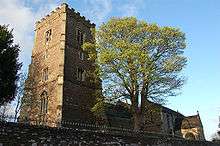
In 1929 St Woolos Church became the Pro-Cathedral of the Diocese of Monmouth, becoming a full cathedral in 1949. When Rowan Williams was appointed Archbishop of Wales in 2000, the Cathedral became the Metropolitan Cathedral of Wales.[30] In 1850 Newport was recognised as the chief centre of Roman Catholicism in Wales when the town became the seat of the Bishop of Newport and Menevia; however Newport lost its bishop with the creation of the Archdiocese of Cardiff in 1916.[3] Between 21 October 1966 and 6 October 1969, having retired as Bishop of Rochester, New York, Fulton J. Sheen, an American bishop who pioneered preaching on television and radio, was appointed the titular archbishop of Newport by Pope Paul VI.
In the 2011 census 56.8% of Newport residents considered themselves Christian, 4.7% Muslim, 1.2% Other religions (including Hindu, Buddhist, Sikh, Jewish and Others), 29.7% were non-religious and 7.5% chose not to answer the non-compulsory religion question on the census.[31] By 2014 the city's Jewish community had reduced to only six members, placing it among the smallest in the UK.[32]
Newport has more than 50 churches[33] (including Welsh, Chinese and Urdu speaking services), 7 mosques,[34] and one synagogue;[35] the nearest Gurudwara[36] is in Cardiff.
The church of St Julian and St Aaron, at St Julian's, was consecrated in 1926.[37][38]
Economy
Newport's Travel to Work Area incorporates much of south Monmouthshire; the new 2001-based area also includes Cwmbran.[39] The city itself has three major centres for employment: the city centre, and business parks clustered around the M4 motorway junctions 24 in the east and 28 in the west.
Organisations based in the city include Airbus Defence & Space; the headquarters of the Office for National Statistics;[40] the headquarters of the United Kingdom Intellectual Property Office (formerly known as the Patent Office); the General Insurance Division of Lloyds TSB; a large Panasonic manufacturing plant; a manufacturing plant for International Rectifier; the headquarters of insurance comparison site Gocompare; the headquarters of Wales and West Utilities; the shared-service centre for HM Prison Service; the Passport Office for much of the south and west of the UK; and the Wales headquarters of the Charity Commission and British Red Cross. In 2014 Admiral Insurance opened a large newly constructed office opposite Newport railway station.
In 1997, Newport secured what was then thought to be Europe's largest-ever inward investment when the LG Group announced a £1.7 billion project creating 6,100 jobs, and supported by public sector grants.[41] Facilities were built on the Celtic Lakes business and science park, but market conditions led to the semiconductor plant never opening, and the CRT plant eventually closed in 2003.[42] In 2005 Irish radiator manufacturer Quinn Group bought the former LG Phillips building, which became its European base.[43]
Industry in the east of Newport was formerly based at the Corus Llanwern steelworks, and although the rolling mill is still active, steel manufacture ceased in 2001. Permission has been granted to transform the 600-acre (2.4 km2) former steelworks site into a £1bn mixed-use development comprising housing, office and industrial space, public open space and a range of community facilities.[44]
At the mouth of the River Usk, the Sims Metal Management plant hosts the world's largest industrial shredder for scrap metal with access by road, rail and sea.[45][46][47][48] The plant, which is also the world's largest car crusher which was featured in the TV series 'How do they do it'.[49]
Newport Cattle Market, in the Pillgwenlly area of the city, closed in 2009 and was demolished to make way for a new supermarket.
Regeneration
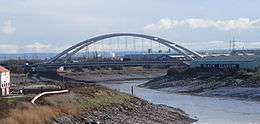
The city has seen major regeneration projects being undertaken since 2004.
Infrastructure
The first stage of regeneration involved improving the city centre road network, including turning Kingsway and Queensway into boulevards. The Southern Distributor Road to the south of the city opened in 2004, including the new City Bridge over the River Usk, improving access and opening up new areas for development. The Newport City footbridge opened in 2006 linking the east and west banks of the river for pedestrians and cyclists.
Newport railway station was redeveloped with the lengthened Platform 4 of the railway station opening in July 2007 and a new terminal building opened in 2010 with a futuristic design. The railway station's reconnection with the Ebbw Valley Railway was due to be completed by 2011 but was delayed. There are plans to reopen many suburban stations in the near future – as part of phase one of the Ebbw Valley reopening, Rogerstone station was re-opened in 2008. Pye Corner station re-opened in 2014 and three others are planned in the city's Unitary Development Plan.[50] Newport bus station was also redeveloped.[51]
A state-of-the-art District General Hospital is envisaged to be built to replace the Royal Gwent Hospital. The former Corus steel Whiteheads site was speculated but this was rejected in favour of redeveloping the Llanfrechfa Grange Hospital site, near Cwmbran as a specialist and critical care unit.
The M4 relief road skirting the southern edge of the urban area of Newport is proposed as a means of reducing the congestion on the existing M4 motorway (presently squeezed through the Brynglas Tunnels) and making Newport and the surrounding areas more accessible. There have also been calls for a barrage across the River Usk to be incorporated with the M4 bypass, so that the level of the river would stay permanently at high tide level, although possible plans for a Severn barrage across the River Severn would reduce the need for a River Usk barrage. The relief road scheme was cancelled in July 2009 but relaunched in 2014.[52]
Leisure
The Riverfront Arts Centre was the first structure to be built as part of Newport's regeneration by Newport City Council in 2004. It stands on Kingsway Boulevard on the west bank of the River Usk. On the east bank, Rodney Parade is being redeveloped as a sports and entertainment complex and it is home to Newport Gwent Dragons, Newport RFC rugby union teams and Newport County football team
Residential
As part of the city's master plan, the city centre is currently being expanded to take in areas of the River Usk east bank. The area of land between Newport Bridge and George Street Bridge is being developed as a £43 million high-density combined commercial and residential area, joined to the west bank by the new footbridge. The plan is designed to show a strong urban form along the river front, emphasised with tall landmark buildings[53] The first phase will be known as City Vizion.[54]
Adjacent to the University campus on the west bank is the site of a potential development called "The Edge". This was to feature 227 apartments, including a 21-storey tower containing duplex apartments and penthouses. However, this development did not take place due to financial problems for the developer. The prime development site is now thought to be in the control of a bank and is likely to be brought forward for development in the future.[55] Further south is the "Newhaus" development of 154 riverside apartments.[56] At the southern end of the site, the "Alexandra Gate" development will eventually see 300 homes and riverside apartments built adjacent to the City Bridge.[57]
In east Newport, land released from the Corus steelworks at Llanwern is being redeveloped as 4,000 houses, shops and other facilities.[58]
Commercial
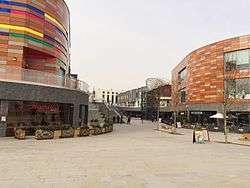
Due to the late-2000s recession, some major redevelopment projects were cancelled. A £210 million city centre shopping complex known as Friars Walk including a Debenhams department store and a multiplex cinema was planned to be created in time for the 2010 Ryder Cup in Newport, but was scrapped in 2009.[59] In December 2010 the Friars Walk scheme was relaunched[60] and in April 2012 a completion date of 2015 was announced with Debenhams again being the flagship store.[61] Newport Council lent the developers £90m to ensure the centre opened on time.[62] It opened in November 2015.[62] As well as 30 new shops there is a dozen restaurants and an eight-screen Cineworld multiplex cinema.[62] City Spires on the Cambrian Centre site would have included a 30-storey block of 238 apartments, 101 metres (331 ft) tall, a 10-storey office block and a four-star hotel. The plan was mothballed in 2008.[63][64] An alternative redevelopment plan for Cambrian Centre started in 2012.[65]
Transport

- See also Category:Transport in Newport, Wales
The M4 motorway comes within a mile (1.6 km) of the city centre, and Newport can be accessed from six junctions (from 24–28 inclusive). The Great Western main railway line also passes through the heart of the city, stopping at Newport railway station. Newport is well linked with nearby Cardiff, with approximately six rail and five bus services between the cities every hour.[66]
Road
M4 Motorway
The main west—east road is the M4 motorway.
The junctions within the city are:
- 24: Coldra A449/A48/B4237
- 25: Caerleon Road B4596
- 25A: Grove Park A4042
- 26: Malpas Road A4051
- 27: High Cross, B4591
- 28: Tredegar Park A48/A4072 (A467/A468)
- 29: St Mellons A48(M) — no access from local roads
Additionally junction 23A lies just outside the city boundaries and provides local access via the A4810 and B4245.
The Brynglas Tunnels on the M4 are a cause of traffic delays as the motorway narrows to two lanes in each direction between junctions 25 and 26 to pass through the tunnels. Partly due to regular tailbacks at the tunnels a variable speed limit is in place between junctions 24 and 28.
Principal roads
Other major west-east A roads are:
- As an alternative to the busy M4 motorway through Newport, the Southern Distributor Road (A48) is a two-lane dual carriageway connecting M4 junction 24 to junction 28. Combined with the M4 in the north, the SDR forms the southern part of a ring road for the city.
- The A48 westbound (Cardiff Road) is as an alternative route from Newport to Cardiff.
- The A48 eastbound (Chepstow Road) is as an alternative route from Newport to Chepstow, South West England (via the Severn Bridge), the Wye Valley and Gloucestershire.
- The A4072 (Forge Road) from M4 junction 28 connects Newport via the A468 to Machen and Caerphilly.
- The A4810 (Queen's Way) connects the SDR at Lee Way to the M4 at junction 23A through the Llanwern Steelworks.
The main north-south A roads are:
- The A449 connects Newport to Usk and the English Midlands via M4 junction 24.
- The A4042 connects Newport to Cwmbran, Pontypool and Abergavenny via M4 junction 25A.
- The A4051 (Malpas Road) connects Newport to Cwmbran via M4 junction 26.
- The A4072 (Forge Road) from M4 junction 28 connects Newport via the A467 to Risca and the towns of the Sirhowy Valley, Ebbw Valley and Rhymney Valley.
The main B roads are:
- The B4237 (former A48) connects M4 junction 24 to junction 28 (Chepstow Road, Wharf Road, crossing George Street Bridge onto George Street and then Cardiff Road).
- The B4596 (Caerleon Road, former A449) links central Newport to Caerleon via M4 Junction 25.
- The B4591 (Risca Road/High Cross Road, former A467) is an alternative route from Newport to Risca via M4 Junction 27 (High Cross) and Rogerstone.
- The B4245 (Magor Road) at Langstone connects Newport to Underwood, Magor and Caldicot.
- The B4239 (Lighthouse Road) at Duffryn connects Newport to Rumney, Cardiff.
City centre

The Old Green Interchange is an elevated roundabout over the A4042 (Heidenheim Drive) at the western end of Newport Bridge. Newport's pedestrianised High Street runs southwest from the interchange through Westgate Square to the pedestrianised Commercial Street. Queensway passes Newport railway station and links the Old Green Interchange to Newport Civic Centre via Clytha Park Road. Kingsway/Usk Way is a boulevard on the west bank of the River Usk linking the Old Green Interchange to the Southern Distributor Road at the western end of City Bridge and to Newport Transporter Bridge.
Corporation Road follows the east bank of the River Usk, but with limited views of the river. It links Newport Bridge to George Street Bridge, Newport City Bridge and, via Stephenson Road, Newport Transporter Bridge.
Bus
Bus services are primarily provided by the council-owned Newport Transport under the Newport Bus brand. Other operators include Stagecoach in South Wales, New Adventure Travel and Cardiff Bus. Newport bus station[67] is to be redeveloped. National Express operate cross-country coach services from the city.
Rail
See also Railway stations in Newport.
Newport railway station is connected directly to the South Wales Main Line branch of the Great Western Main Line, Welsh Marches Line and Gloucester to Newport Line.
Rogerstone railway station on the Ebbw Valley Railway reopened in 2008. Services currently run between Ebbw Vale and Cardiff via Rogerstone. The reconnection of Newport station to the Ebbw Valley Railway via Rogerstone station is under consideration, but no decision will be made until at least 2011.[68]
The services calling at Newport are:
- First Great Western
- London Paddington – Reading – Bristol Parkway – Newport – Cardiff Central (- Bridgend – Port Talbot – Neath – Swansea)
- Cardiff Central – Newport – Bristol Temple Meads – Bath Spa – Salisbury – Southampton – Portsmouth Harbour
- Cardiff Central – Newport – Bristol Temple Meads – Weston-super-Mare – Taunton
- Arriva Trains Wales
- Manchester Piccadilly – Stockport - Crewe – Shrewsbury – Hereford – Cwmbran – Newport – Cardiff Central (– Bridgend – Port Talbot – Neath – Swansea – Carmarthen – Haverfordwest)
- Cardiff Central – Newport – Cwmbran – Hereford – Shrewsbury – Wrexham General – Chester – Rhyl – Bangor – Holyhead
- Maesteg – Bridgend – Cardiff Central – Newport – Chepstow – Gloucester – Cheltenham Spa
- CrossCountry
- Cardiff Central – Newport – Gloucester – Cheltenham Spa – Birmingham New Street – Nottingham

Newport railway station underwent a £22 million refurbishment programme, completed in time for the Ryder Cup in October 2010. The project introduced a futuristic new passenger terminal and bridge, whilst restoring the 19th-century features of the site. The new complex, west of the old station entrance, includes two terminals, new terminal buildings and a public footbridge, a new passenger footbridge, a new taxi area and short-stay car park, and a 250-space passenger car park.
Air
The nearest airport with scheduled domestic and international flights is Cardiff Airport, 30 miles (48 km) south west of Newport.[69]
In 2003, a proposal for a new Severnside airport near Newport was rejected by the Department for Transport. The airport would have featured runways on a man-made island in the Severn Estuary.[70]
Bridges in Newport
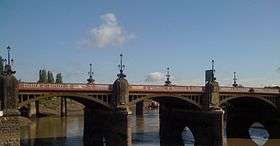

Newport has nine public bridges spanning the River Usk, connecting the east and west of the city. From north to south they are: Caerleon Bridge, St. Julian's railway bridge, M4 motorway Usk bridge, Great Western Railway Usk bridge, Newport Bridge, Newport City footbridge, George Street Bridge, City Bridge and Transporter Bridge. In addition, the Twenty Ten Bridge at the Celtic Manor Resort is a footbridge crossing the River Usk north of Caerleon Bridge and open to the public.
Timeline:
1800: First stone Newport Bridge
1806: Caerleon Bridge
1850: South Wales Railway Usk Bridge
1866: Newport Road Bridge widened
1866: St. Julian's railway bridge
1888: Great Western Railway Usk bridge
1906: Transporter Bridge
1911: Great Western Railway Usk bridge widened
1927: Current Newport Bridge
1964: George Street Bridge
1967: M4 motorway Usk bridge
1989: M4 motorway Usk bridge, additional crossings
2004: City Bridge
2006: Newport City footbridge
2010: Twenty Ten Bridge
Notable buildings and structures
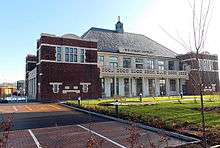
See the following categories:
- Buildings and structures in Newport, Wales
- Landmarks in Newport, Wales
- Visitor attractions in Newport, Wales
Many of the landmarks of Newport are in Newport city centre or within a short walking distance of the centre; the Railway station, Bus station, Castle, Westgate Hotel, Market, Museum Art Gallery and Central Library, Cathedral, Transporter Bridge, Newport Bridge, Newport City footbridge, George Street Bridge, City Bridge, University of South Wales, Riverfront Arts Centre, Dolman Theatre, Newport Centre, Civic Centre, Newport Technical Institute (former Art College), Shire Hall, Belle Vue Park, Rodney Parade, Newport Crown Court, Ye Olde Murenger House, St Mark's church, St Paul's church, and Royal Gwent Hospital.
The city has a number of churches of architectural merit. See Category:Churches in Newport, Wales.
Other landmarks include:
- Cenotaph – World War I and World War II memorial in Clarence Place.
- Main Post Office – retained façade of the former main Post Office building in High Street adjacent to the old Corn Exchange. A blue plaque states: "Site of Newport's first Head Post Office. Built in 1844 and rebuilt in 1907, the Edwardian façade being preserved in the total reconstruction of the island site in 2001. Once housed the town's first telephone exchange, known as The Savoy. Listed Grade II in 1985."
- Kings Hotel – former hotel in High Street dated c.1812, currently being redeveloped as apartments
- Newport Arcade – Victorian arcade linking High Street to Cambrian Road.
- Market Arcade – Victorian arcade linking High Street to Market Street.
- Waterloo Hotel – Grade II-listed building in Alexandra Road, Pillgwenlly, currently operating as a bistro.
- Masonic Hall – Grade II-listed building at 109 Lower Dock Street.
- Burton Almshouses – almhouses located on Friars Road, built 1900.
- The Old Rising Sun – former public house on Shaftesbury Street, Shaftesbury
- West Usk Lighthouse – operating as a hotel.
- Beechwood House – at Beechwood Park.
- Brynglas House – operating as an adult-education centre.
- Church of St Mary, Nash – the 12th-century parish church of Nash near Newport[71] described by local historian Fred Hando as "the Cathedral of the Moors".[9]
- Lysaght Institute – former working men's club for steelworkers when the Orb Works steel plant moved from Wolverhampton. Built 1928, refurbished 2012.[72]
Shopping

- See also Category:Shopping in Newport, Wales
City centre
The main shopping streets of Newport city centre are pedestrianised with High Street and Commercial Street forming the north /south axis plus adjoining roads including Newport Arcade, Market Arcade, Skinner Street, Bridge Street, Upper Dock Street, Market Street, Griffin Street, Corn Street, Cambrian Road, Hill Street and Llanarth Street.
The five roads of Commercial Street, Stow Hill, Bridge Street, High Street and Skinner Street converge at Westgate Square (named after the Westgate Hotel) and this is generally regarded as the central point the city.
Kingsway Shopping Centre is an indoor shopping mall. The adjoining £90M Friars Walk shopping centre opened in November 2015; this has 30 shops, about 12 restaurants and an 8-screen cinema.[62] Newport Market is a Victorian indoor market on two floors with outlets for produce and general products.
Retail parks
Outside of the city centre large retail parks are established off the Southern Distributor Road:
- Newport Retail Park is to the east at Lliswerry – M4 motorway Junction 24 (Coldra), then A48 (Ringland Way/Spytty Road).
- Three retail parks (Harlech, Maesglas and 28 East) around Maesglas to the west of the city – M4 motorway Junction 28 (Tredegar Park), then A48.
Notable people
Education

The University of South Wales campus is on the west bank of the river Usk in Newport city centre. The university can trace its roots to the founding of the Newport Mechanics Institute in 1841. Newport School of Art, Media and Design was one of the first Art Schools to be awarded degree status in 1973 and enjoyed a high reputation in painting,[73] Fine Art,[74] and sculpture[74] throughout the 1960s and 1970s. It is still highly regarded however, especially in documentary photography.[75] The Fine Art course closed in 2013, its final degree show entitled 'depARTure'.[76]
Newport also has the further-education Coleg Gwent City of Newport Campus, informally known as Nash College, in Lliswerry. Brynglas House is currently an Adult Education Centre.
Newport has eight state comprehensive schools (Bassaleg School, Duffryn High School, Newport High School, St Joseph's Roman Catholic High School, Caerleon Comprehensive School, Lliswerry High School, Llanwern High School and Saint Julian's School) and one independent comprehensive school (Rougemont School). All schools are governed by Newport Local Education Authority. Education is generally conducted in English language but in schools at least a mandatory Welsh language content must be provided under the Welsh education curriculum.
Newport has three Welsh-medium primary schools; Ysgol Gymraeg Bro Teyrnon in Brynglas, Ysgol Gymraeg Casnewydd in Ringland and Ysgol Gymraeg Ifor Hael in Bettws. The nearest Welsh-medium secondary school is Ysgol Gyfun Gwynllyw in Trevethin, Pontypool.
A Football Academy is based at Llanwern High School. It was established in 1998 as a partnership of Newport County Football Club and Newport City Council. The academy has a development programme of around 50 students undertaking sporting qualifications. The students compete in the South West Counties League as Newport County's youth team.
Culture and arts
- See also Category:Culture in Newport, Wales
Newport Transporter Bridge is one of the few remaining working bridges of its type in the world and featured in the film Tiger Bay. Visitors can travel on the suspended cradle most days and can walk over the top of the steel framework on bank holidays. The only other British example is Middlesbrough Transporter Bridge. Open days are occasionally held to view the renovation of the historically important Newport Ship.
Newport has a modern purpose-built theatre and arts venue, the Riverfront Arts Centre and regular productions at the Dolman Theatre.
The city has many works of civic art including:
- The 40 feet (12 m) high steel Wave by Peter Fink (1991), on the west bank of the River Usk.
- Twelve painted murals by Hans Feibusch (1961–64) at the Newport Civic Centre.
- Tiled murals by Kenneth Budd (1975) at the Old Green Interchange.
- Union, Prudence, Energy statues commemorating the Chartist Newport Rising outside the Westgate Hotel. Created by Christopher Kelly (1991).
- Stand and Stare' statue by Paul Bothwell Kincaid, in Commercial Street, commemorating the work of poet W. H. Davies, who was born in Newport and lived his early life there. Davies is best known for his poem Leisure; "What is this life if, full of care, We have no time to stand and stare".
- Statue of Charles Morgan, 1st Baron Tredegar, in Bridge Street, created by John Evan Thomas (1850).
- Merchant Navy Memorial statue (1991) by Sebastien Boyesen at Gilligan's Island.
- This Little Piggy statue by Sebastien Boyesen (1994) outside Newport Market.
- The Vision of St.Gwynllyw/The Bell Carrier statue by Sebastien Boyesen (1996) in Llanarth Street.
- Archform sculpture by Harvey Hood at Newport Railway Station.[77]
- In the Nick of Time, known locally as the Newport Clock, by sculptor Andy Plant at Glan Llyn, Llanwern. Formerly stood in John Frost Square.
- British Women's Temperance Association Drinking Fountain (1913) - terracotta fountain, at Newport Cathedral, made by Royal Doulton.
- Stone memorial to the Allied invasion of Europe on 6 June 1944 in High Street.
- Chartist Frieze commemorating the Chartist Newport Rising in Friars Walk by Sebastien Boyesen (2015).
Newport has three major museums: Newport Museum in the city centre and at Caerleon the National Roman Legion Museum and Roman Baths Museum. Newport Central Library is located within Newport Museum. In July each year an Arts festival is held in Caerleon and Roman Military re-enactment in the amphitheatre, the largest restored amphitheatre in Britain. The remains of the Roman baths, barracks and fortress walls of Isca Augusta can be seen at Caerleon. Caerleon also has literary associations to the legend of King Arthur through Geoffrey of Monmouth and later Arthur Machen (who was born in Caerleon) and Alfred Lord Tennyson wrote his Idylls of the King in Caerleon.
The Newport Festival runs throughout the summer months with a large number of events being staged in the city centre and elsewhere in the city.[78]
Set in a park of 90 acres (36 ha), Tredegar House is an example of a 17th-century Charles II mansion. The earliest surviving part of the building dates back to the late 15th century. For over five hundred years, it was home to the Morgans – later Lords Tredegar – until they left in 1951. The house was then bought by the Catholic Church and used as a girls' school until it was bought by the council in 1974, which led to it being described as the "grandest council house in Britain".[79]
Newport hosted the National Eisteddfod of Wales in 1897, 1988 and 2004.
A 115 feet (35 m)-long mosaic Chartist Mural was created in 1978 near John Frost Square to commemorate the Chartist rising of 1839. It was demolished amid protests in October 2013 to make way for city centre redevelopment.[80][81][82][83] A trust was set up to commission a new memorial with £50,000 of funding provided by Newport City Council[84] In 2014 the Newport Chartist Commission, with members Dame Rosemary Butler, Pat Drewett and Rowan Williams, sought to recruit a project manager.[85]
As part of the city's "Big Splash" festival, on 30 August 2010, 45-year-old French circus star Olivier Roustan from Toulouse, performed the highest ever wirewalk in Europe, along the top cable of the Newport City Footbridge.[86]
Newport hosted an outdoor art exhibition called "SuperDragons" in 2010 which displayed 60 large dragons decorated by local community groups.[87]
In November 2013 the Newport Arts, Culture and Heritage Association (NACHA), which promotes "the past, present and future of the arts, culture and heritage of the people of Newport, South Wales" was launched on Facebook.[88] In December 2014 chairman of the Friends of Newport Museum and Art Gallery, Richard Frame, expressed alarm at Newport City Council proposals to close the museum in 2015.[89]
Music and nightlife
- See also Category:Music venues in Newport, Wales
The city centre has many pubs, bars and nightclubs, mostly in the vicinity of High Street. The most famous of these was TJ's, an alternative music club where it is claimed that Kurt Cobain of Nirvana proposed to Courtney Love, which closed in 2010.[90] TJ's was voted one of the top 50 'Big Nights Out' in the world by FHM in December 1997[91]
Newport Centre and the Riverfront Arts Centre are popular concert venues. Other live music venues in the city centre include NEON, Six Feet Under, Le Pub, Riverside Tavern, Warehouse 54, El Sieco's and The Potters. Outdoor music events are held in the summer months at Beechwood Park, Belle Vue Park, Rodney Parade, the Pillgwenlly carnival and Maindee carnival.
Newport is the subject of a 2010 song "Newport (Ymerodraeth State of Mind)",[92] a parody of the Alicia Keys song "Empire State of Mind." The video went viral, was featured on BBC News,[93] and by August 2010, nearly 2.5 million people had watched it on YouTube. YouTube removed the video due to a copyright claim by music publishers.[94][95] Newport-based rap group Goldie Lookin Chain released a 'parody of a parody' video in response, alleging that their rivals lacked local knowledge.[96]
City of Newport Male Choir[97] is one of the leading male voice choirs in the region
Parks and playing fields
- See also Category:Parks in Newport, Wales
The main municipal parks in Newport are Tredegar Park, Belle Vue Park and Beechwood Park. The main municipal playing fields are at Tredegar Park, Coronation Park, Glebelands, Pillgwenlly sports ground, Kimberley Park, Shaftesbury Park and Caerleon Broadway.
Walking, cycling and leisure sports
To the south of the city lies the extensive Caldicot and Wentloog Levels and Newport Wetlands Reserve. The Wetlands reserve opened in March 2000 as a mitigation for the loss of mudflats caused by the building of the Cardiff Bay Barrage.[98] A Local Nature Reserve is established at Allt-yr-yn.
Newport City footbridge is a cycle and pedestrian bridge in Newport city centre linking the east and west banks of the River Usk.
A cycle and pedestrian walkway on the west bank of the River Usk links Newport city centre at Crindau to central Caerleon.[99] There is a marked heritage trail in Caerleon. A cycle and pedestrian walkway is on both banks of the River Usk. The East bank path links Newport Bridge to Lliswerry. The West bank path links Newport Bridge to Newport Transporter Bridge and to Lliswerry via Newport City Bridge.[100] It is therefore possible to walk or cycle from the north to the south of the City whilst largely avoiding public roads.
The Celtic Trail cycle route and National Cycle Route 4 passes through Newport.
The main municipal leisure sports facilities are based at Newport Centre in the city centre, Newport International Sports Village at Lliswerry and the Newport Active Living Centre at Bettws. There is a purpose-built indoor bowls arena at the Glebelands.
The city has a thriving Scout District.[101]
Sport
- See also Category:Sport in Newport, Wales
Rugby
The exploits of Newport RFC are world-renowned. One of the few clubs to have beaten all the major southern hemisphere touring sides, they were the only side to beat the Invincible All Blacks of 1963–64. Amongst the names associated with the club are Arthur 'Monkey' Gould, the first rugby union superstar, and David Watkins, the only man to have captained Great Britain at rugby union and rugby league. Since the regionalisation of Welsh club rugby in 2003, Newport RFC play in the Welsh Premier Division and operate as a feeder club to the Newport Gwent Dragons regional team who play in the Pro12 League. Both Newport RFC and Newport Gwent Dragons play at Rodney Parade near Newport city centre. Nine other rugby union teams playing in the Welsh League are based in Newport; Newport Saracens, Pill Harriers, Newport High School Old Boys, Bettws, Caerleon, Hartridge, Rogerstone, St Julians High School Old Boys and Whiteheads.
Newport's rugby league club are called the Newport Titans and play in the Welsh Conference Premier.
Football
Newport's best known association football club is Newport County, who were formed in 1912 and joined the Football League in 1920. Newport County have played in the second tier of English football and spent 60 seasons in the Football League, reached the last 16 of the FA Cup, won the Welsh Cup in 1980 and subsequently reached the quarter-finals of the European Cup Winners' Cup in 1981. They were relegated from the Football League in 1988 and went bankrupt the following year. The club re-formed shortly afterwards and entered the English league pyramid system at a much lower level. The club achieved promotion back to the Football League for the 2013–14 season after a 25-year absence, and now play in Football League Two.
Newport is also home to five teams that play in the Welsh Football League: Caerleon, Lliswerry, Newport City, Newport Civil Service and Newport YMCA,. The city has its own league, the Newport and District Football League, which is part of the Welsh football league system and consequently some Newport clubs field teams in the Gwent County League. Lovell's Athletic were a fairly well known team in the mid-20th century – due to the suspension of League football during the Second World War they were the premier team in the city, as Newport County did not field a side. During this period they managed to reach the 3rd round of the FA Cup in the 1945–46 season.
Dragon Park, the Football Association of Wales' National Football Centre, is located at the Newport International Sports Village. The centre also provides the headquarters for the Welsh Football Trust.
Golf
The city is home to the Celtic Manor Resort, a five-star conference resort and home of the Wales Open, the annual European Tour golf tournament. The resort was the venue for the All*Star Cup celebrity golf tournament in 2005 and for the 2010 Ryder Cup.
The city has high-quality golf facilities at Llanwern Golf Club, Peterstone Golf Club, Parc Golf Academy in Coedkernew and Newport Golf Club and Tredegar Park Golf Club in Rogerstone. Caerleon has a good quality nine-hole municipal course, driving range and clubhouse.
Within a short drive of Newport are golf clubs at St Mellons, Dewstow, Shirenewton, St Pierre, Greenmeadow, Woodlake, Alice Springs, Pontypool and Raglan.
Cycling
The Newport International Sports Village at Lliswerry includes the Wales National Velodrome, the head office of Welsh Cycling.
Tennis
Newport was a key venue for British Tennis. The 'World Group' Ties for the 1906 International Lawn Tennis Challenge (forerunner to the Davis Cup) were hosted at Newport Athletic Club.
Other sports

The Newport International Sports Village has been home to Newport Cricket Club since moving from Rodney Parade in 1990.
For many years the city had a motorcycle speedway team Newport Wasps but the team was disbanded in 2012.
Newport is one of three main cities where British baseball is still played – the others are Cardiff and Liverpool – and the city hosts a Wales-England international match every four years at Coronation Park.
South East Wales Regional Swimming Pool is located at Newport International Sports Village. Newport Tennis Centre is also located at the complex and is a municipal multi-sport facility for tennis (indoor and outdoor), five–a-side football, basketball, hockey, netball, table tennis, badminton and squash.
Newport Squash Club has four courts situated in the grounds of Rodney Parade and the club operates a public pay-per-play arrangement there.
St. Joseph's Amateur Boxing Club is situated on George Street and is the home club of Yemeni-born 2006 Commonwealth bronze medallist Mo Nasir[102] and 2010 Commonwealth Silver medallist Sean McGoldrick.[103]
Treetops Shooting Ground, Coedkernew is one of Britain's best equipped Clay pigeon shooting grounds and often hosts competitions between local shooting clubs and University clay shooting clubs from around South Wales and South West England.
Newport hosted the International Cross Country Championships (1903-1972) on six occasions (1906, 1911, 1921, 1927, 1933 and 1955) at Caerleon Racecourse.
Newport has a Skittle Alley League consisting of over 50 teams who play their league games on a Friday evening.
Annual sporting events
The city is currently home to a number of annual sporting events, including:
- The Wales Open European Tour golf tournament
- The Elemis Invitational Trophy tennis tournament
- The Welsh Open world ranking snooker tournament
- The World Cup of Pool
- The Newport Half Marathon
Local media
Newport's local newspaper is the South Wales Argus, which is published in the city and distributed throughout the city and surrounding area.[104] Local analogue radio broadcasting licences cover the Cardiff/Newport area; the FM licence is held by Cardiff Broadcasting Co. Ltd., broadcasting as Capital FM South Wales from Cardiff Bay and the AM licence is held by Capital Radio plc, broadcasting as Capital Gold.[105] The local DAB ensembles are Cardiff and Newport (11C) and South Wales and Severn Estuary (12C).
Newport has several internet radio stations, the most popular of which is Newport City Radio.[106]
Twinning
Newport has three international twinning[107] links:
 Heidenheim, Germany, since 1980
Heidenheim, Germany, since 1980 Kutaisi, Georgia, since 1989
Kutaisi, Georgia, since 1989 Guangxi Province, China, since 1996
Guangxi Province, China, since 1996
See also
References
- ↑ 2011 census
- ↑ "NATO summit coming to Newport's Celtic Manor". South Wales Argus. 31 October 2013.
- 1 2 3 4 5 6 7 8 9 10 11 12 13 14 15 The Welsh Academy Encyclopedia of Wales. Cardiff: University of Wales Press 2008.
- ↑ Archæologia Cambrensis. Cambrian Archæological Association, 1859. Retrieved 27 September 2007.
- ↑ "A Summary of the Early History of Newport". Bob Trett, newportpast.com. Retrieved 1 October 2007.
- ↑ Bradney, Joseph Alfred (1993). Gray, Madeleine, ed. A History of Monmouthshire, Volume 5: The Hundred of Newport. South Wales Record Society. p. 23. ISBN 0950867675. Retrieved 9 May 2013.
- 1 2 "A Brief History of Newport". Tim Lambert. Retrieved 9 October 2008.
- ↑ "Owain Glyndwr, The Bell at Caerleon". The Bull Inn, Caerleon, June 2007. Retrieved 9 October 2008.
- 1 2 Hando, Frederick James (1958). Out and About in Monmouthshire. Newport: R. H. Johns.
- ↑ "Newport: the Tom Toya Lewis". Geograph.org.uk. Retrieved 22 January 2013.
- ↑ "Newport: foundation stone of YMCA in Commercial Street". Geograph.org.uk. Retrieved 22 January 2013.
- ↑
- ↑ "The Motorway Archive: The M4 in Wales". Ukmotorwayarchive.org. Retrieved 22 January 2013.
- ↑ "The Inmos Legacy". Inmos.com. Retrieved 22 January 2013.
- ↑ "''Real Newport'', Seren Books". Seren-books.com. Retrieved 22 January 2013.
- ↑ Letters Patent dated 15 May 2002
- ↑ "Newport Transporter Bridge". Geograph.org.uk. Retrieved 22 January 2013.
- 1 2 Mills, Hayley (17 August 2013). "Newport County awarded Freedom of the City". South Wales Argus. Retrieved 7 October 2013.
- ↑ "Field Marshal Montgomery is awarded the Freedom of Newport, 29 September 1945 (photograph)". People's Collection Wales. Retrieved 7 October 2013.
- ↑ "Newport City: HMS Severn". Newport City Council. Retrieved 7 October 2013.
- ↑ "Newport County awarded Freedom of the City". South Wales Argus. 17 August 2013. Retrieved 7 October 2013.
- ↑ "Newport rugby freedom presentation". Newport City Council. Retrieved 31 October 2013.
- ↑ "Mean July temperature in the UK". The Met Office. Retrieved 8 October 2007.
- ↑ "Mean July rainfall in the UK". The Met Office. Retrieved 8 October 2007.
- ↑ "Mean January temperature in the UK". The Met Office. Retrieved 8 October 2007.
- ↑ "Mean January rainfall in the UK". The Met Office. Retrieved 8 October 2007.
- ↑ "Average annual sunshine totals in the UK". The Met Office. Retrieved 8 October 2007.
- ↑ "The coldest days of each year in the UK". T.A. Harley. Retrieved 30 December 2006.
- ↑ Statistics, Neighbourhood. "2011 Census: Newport Ethnicity". 2011 Census Key Statistics. ONS (Office for National Statistics). Retrieved 3 February 2013.
- ↑ "Diocese of Monmouth – Newport Cathedral". Church in Wales.
- ↑ Newport 2011 Census Religion
- ↑
- ↑ "Established Christian churches in Newport". Churches Together Newport. Retrieved 26 September 2006.
- ↑ "Mosques in Newport". New Muslim Network. Retrieved 27 August 2006.
- ↑ "Synagogues in Newport". JewishGen. Retrieved 26 September 2006.
- ↑ "Gurudwara near Newport". AllAboutSikhs.com. Archived from the original on 7 May 2006. Retrieved 26 September 2006.
- ↑
- ↑
- ↑ National Statistics, Introduction to the 2001-based Travel-to-Work Areas Archived 5 March 2009 at the Wayback Machine.
- ↑ Archived 14 August 2006 at the Wayback Machine.
- ↑ "LG Group makes Europe's biggest inward investment". Prnewswire.co.uk. Retrieved 22 January 2013.
- ↑ "Wales | LG: The dream that died". BBC News. 22 May 2003. Retrieved 22 January 2013.
- ↑ "Newport City Council press release – Quinn Group move provides 465 new jobs for Newport". Newport.gov.uk. Retrieved 22 January 2013.
- ↑ "Newport – City Centre Redvelopment – Eastern Newport". Newport.gov.uk. Retrieved 22 January 2013.
- ↑ Sims UK opens multi-million pound metals recycling terminal LetsRecycle, 17 November 2004. Retrieved 3 June 2010.
- ↑ Newport Hosts one of Europe's largest recycling facilities Materials Network Wales, Summer 2006. Retrieved 3 June 2010.
- ↑ Powering the World’s largest Industrial Shredder weg.net, 30 September 2009. Retrieved 3 June 2010.
- ↑ Man Made: World's biggest shredder National Geographic Channel. Retrieved 3 June 2010.
- ↑ "Car-Crushing Giant Starts Up". BBC News. 17 November 2004. Retrieved 22 January 2013.
- ↑ "Newport Unitary Development Plan" (PDF). Newport City Council. Retrieved 30 August 2006.
- ↑ "Start of works on Kingsway Centre".
- ↑ M4 Toll Newport Bypass at cbrd.co.uk
- ↑ "Rodney Parade Supplementary Planning Guidance" (PDF). Newport City Council. Archived from the original (PDF) on 30 June 2007. Retrieved 20 July 2006.
- ↑ "City Vizion". Taylor Wimpey plc. Retrieved 30 August 2007.
- ↑ "The Edge Newport". Edward Ware Homes Ltd. Retrieved 2 October 2006.
- ↑ "Newhaus Riverside Apartments, Newport". Westmark. Retrieved 2 October 2007.
- ↑ "Alexandra Gate, Newport". Redrow Homes (South Wales) Ltd. Archived from the original on 15 September 2007. Retrieved 2 October 2007.
- ↑ "Llanwern regeneration". St. Modwen Developments LTD. Retrieved 30 August 2006.
- ↑ "Friars Walk Shopping Centre". Newport City Council. Retrieved 30 August 2006.
- ↑ "Friars Walk relaunched". Southwalesargus.co.uk. 16 December 2010. Retrieved 22 January 2013.
- ↑ Nick Servini (19 April 2012). "Friars walk relaunch". Bbc.co.uk. Retrieved 22 January 2013.
- 1 2 3 4 BBC News, Newport's £90m Friars Walk shopping complex opens, 12 November 2015.
- ↑ "City Spires development". Modus Properties. Retrieved 7 October 2006.
- ↑ "Regeneration in Newport". city.newport.net. Retrieved 5 January 2007.
- ↑ "Cambrian Centre redevelopment". Southwalesargus.co.uk. 18 April 2012. Retrieved 22 January 2013.
- ↑ "Train Info – Plusbus" (PDF). Ptsllibrary.co.uk. Retrieved 22 January 2013.
- ↑ ST3188 : Newport Bus Station, geograph.org.uk. Retrieved 21 December 2010
- ↑ "Ebbw Vale to Newport rail decision 'in 2011'". BBC News. 20 July 2010. Retrieved 20 July 2010.
- ↑ "Newport – host city to the 2010 Ryder Cup". Newport.gov.uk. Retrieved 22 January 2013.
- ↑ "Wales | New £2bn airport plan dropped". BBC News. 16 December 2003. Retrieved 22 January 2013.
- ↑ "900 year old church in Nash". Southwalesargus.co.uk. 6 August 2010. Retrieved 22 January 2013.
- ↑ www.lysaght-institute.com
- ↑ "painting". Amd.newport.ac.uk. Retrieved 23 January 2013.
- 1 2 "Film, Photography and Digital Media". Amd.newport.ac.uk. Retrieved 23 January 2013.
- ↑ "Film, Photography and Digital Media". Amd.newport.ac.uk. Retrieved 23 January 2013.
- ↑ "Newport state of mind: last ever degree show as BA Fine Art course closes". Art News. 11 June 2013. Retrieved 8 October 2013.
- ↑
- ↑ "Newport Festival website". Newport.gov.uk. Retrieved 22 January 2013.
- ↑ "Tredegar House: A brief history of the building". Newport City Council. Retrieved 24 February 2011.
- ↑ Natalie Crockett, "Chartist mural to be re-created in library", South Wales Argus, 22 March 2012. Retrieved 7 October 2013
- ↑ Nick Dermody, "Newport Chartist mural artwork faces demolition", BBC News, 23 March 2012. Retrieved 7 October 2013
- ↑ "Newport Chartist mural: Protest as demolition takes place", BBC News, 3 October 2013. Retrieved 7 October 2013
- ↑ "Anger as Newport council demolish Chartist Mural", South Wales Argus, 4 October 2013. Retrieved 7 October 2013
- ↑ Chartist Trust
- ↑
- ↑ "Tightrope walker Olivier Roustan 250ft above Newport". BBC News. 31 August 2010. Retrieved 9 May 2013.
- ↑ "Newport SuperDragons". Retrieved 28 January 2011.
- ↑
- ↑
- ↑ "Newport venue TJ's to close". NME. 20 April 2010. Retrieved 22 January 2013.
- ↑ Mansfield, Ruth (15 March 2010). "Owner of legendary TJs – John Sicolo – dies". South Wales Argus. Retrieved 23 October 2010.
- ↑ "Newport (Ymerodraeth State of Mind)". YouTube. 12 August 2010. Retrieved 9 May 2013.
- ↑ "Spoof 'Newport State of Mind' video becomes web hit". BBC News. 24 July 2010. Retrieved 9 May 2013.
- ↑ "Newport State of Mind removed amid copyright claim". BBC South East Wales. 10 August 2010. Retrieved 9 May 2013.
- ↑ Bloxham, Andy (11 August 2010). "Newport State of Mind parody removed over copyright issues". Daily Telegraph. Retrieved 9 May 2013.
- ↑ "Goldie Lookin Chain respond to spoof Newport video". BBC South East Wales. 9 August 2010. Retrieved 9 May 2013.
- ↑ Dennis Havard (21 July 2007). "Newport Male Choir". Homepage.ntlworld.com. Retrieved 22 January 2013.
- ↑ "RSPB Newport Wetlands Reserve". Rspb.org.uk. Retrieved 22 January 2013.
- ↑ "Caerleon cycle path extension". Southwalesargus.co.uk. 9 June 2011. Retrieved 22 January 2013.
- ↑ "east bank walkway completed". Southwalesargus.co.uk. 29 October 2011. Retrieved 22 January 2013.
- ↑ "Newport District Scouts". newportscouts.org. 2013. Retrieved 13 August 2013.
- ↑ Boxing discipline aids drug fight , news.bbc.co.uk, 31 May 2008. Retrieved 21 December 2010.
- ↑ "Sean McGoldrick at Commonwealth games". Southwalesargus.co.uk. 14 October 2010. Retrieved 22 January 2013.
- ↑ "South Wales Argus". South Wales Argus. Retrieved 22 January 2013.
- ↑ "Radio Authority renews local licences for Cardiff/Newport". Ofcom.org.uk. Retrieved 22 January 2013.
- ↑ "newportcityradio.org". newportcityradio.org. 24 May 2012. Retrieved 22 January 2013.
- ↑ "Town twinning". Newport City Council. Retrieved 27 August 2006.
External links
| Wikimedia Commons has media related to Newport, Wales. |
| Wikivoyage has a travel guide for Newport (Monmouthshire). |
- Newport, Wales at DMOZ
- Newport City Council
- City Centre information
- Newport Civic Society
- Port of Newport
- Newport's War Dead
- 'Newport First Stop' - 100 Years of News Stories at newportpast.com


